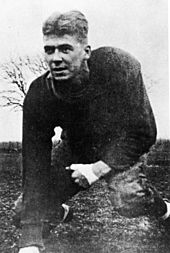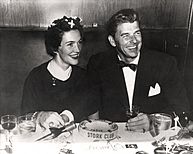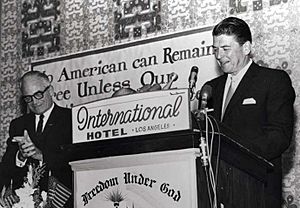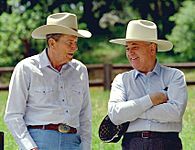Ronald Reagan facts for kids
Quick facts for kids
Ronald Reagan
|
|
|---|---|
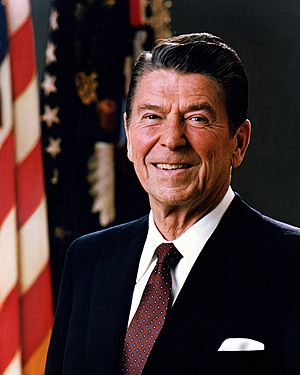
Official portrait, 1981
|
|
| 40th President of the United States | |
| In office January 20, 1981 – January 20, 1989 |
|
| Vice President | George H. W. Bush |
| Preceded by | Jimmy Carter |
| Succeeded by | George H. W. Bush |
| 33rd Governor of California | |
| In office January 2, 1967 – January 6, 1975 |
|
| Lieutenant |
|
| Preceded by | Pat Brown |
| Succeeded by | Jerry Brown |
| 9th and 13th President of the Screen Actors Guild | |
| In office November 16, 1959 – June 7, 1960 |
|
| Preceded by | Howard Keel |
| Succeeded by | George Chandler |
| In office March 10, 1947 – November 10, 1952 |
|
| Preceded by | Robert Montgomery |
| Succeeded by | Walter Pidgeon |
| Personal details | |
| Born |
Ronald Wilson Reagan
February 6, 1911 Tampico, Illinois, U.S. |
| Died | June 5, 2004 (aged 93) Los Angeles, California, U.S. |
| Resting place | Ronald Reagan Presidential Library |
| Political party | Republican (from 1962) |
| Other political affiliations |
Democratic (until 1962) |
| Spouses | |
| Children | 5, including Maureen, Michael, Patti, and Ron |
| Parents | |
| Relatives | Neil Reagan (brother) |
| Alma mater | Eureka College (BA) |
| Occupation |
|
| Awards | Full list |
| Signature | |
| Military service | |
| Service | |
| Years of service |
|
| Rank | |
| Unit |
|
| Wars | |
|
Other offices
1968–1969: Chair of the Republican Governors Association
|
|
Ronald Wilson Reagan (RAY-gən; February 6, 1911 – June 5, 2004) was an American politician and actor. He served as the 40th president of the United States from 1981 to 1989. Reagan was a member of the Republican Party. He is known as one of the most important conservative leaders in the U.S.
Contents
Early Life and Education
Ronald Wilson Reagan was born on February 6, 1911. His birthplace was a commercial building in Tampico, Illinois. He was the younger son of Nelle Clyde Wilson and Jack Reagan.
School and College Years
Reagan went to Dixon High School. There, he became interested in drama and football. His first job was as a lifeguard at the Rock River.
In 1928, Reagan started attending Eureka College. He was an average student but was active in sports, drama, and student politics. He became the student body president. He also joined a student strike that led to the college president leaving.
Reagan played football for Eureka College in 1930 and 1931. He remembered a time when two Black teammates were not allowed service at a segregated hotel. He invited them to his parents' home nearby. His parents welcomed them, which was very open-minded for that time.
Entertainment Career
After graduating from Eureka College in 1932, Reagan worked as a sports broadcaster. He covered football games and later baseball games for the Chicago Cubs. He would describe games using only basic updates sent by wire. He often spoke out against racism during this time.
Becoming a Movie Star
In 1936, Reagan took a screen test in California. This led to a seven-year contract with Warner Bros.. He arrived in Hollywood in 1937 and made his first movie, Love Is on the Air.
Reagan made many films, mostly "B films" (lower-budget movies). He became well-known for playing George Gipp in Knute Rockne, All American (1940). Reporters later called him "the Gipper" during his political campaigns. His role in Kings Row (1942) was considered his best acting performance.
World War II interrupted his movie career. After the war, he continued acting but didn't reach the same level of stardom. He appeared in 53 films in total. His last movie was The Killers (1964).
Leading the Screen Actors Guild
Reagan also served as the president of the Screen Actors Guild (SAG). This is a union for actors. He held this position from 1947 to 1952 and again from 1959 to 1960.
Military Service During WWII

In 1937, Reagan joined the United States Army Reserve. Because of his severe near-sightedness, he could not serve in combat. Instead, he was assigned to the United States Army Air Forces (AAF).
He worked for the 18th AAF Base Unit in Culver City. Here, he helped produce over 400 training films for the military. He was discharged as a captain in December 1945.
Family Life
Reagan married actress Jane Wyman in January 1940. They had two daughters, Maureen and Christine (who died shortly after birth). They also adopted a son, Michael. They divorced in 1949.
Later, Reagan met Nancy Davis through his work at the Screen Actors Guild. They married in March 1952. They had two children, Patti and Ron.
Television Career
Reagan became the host of the TV show General Electric Theater. He and Nancy also acted together in some episodes. The show was popular but was canceled in 1962. He later hosted another show called Death Valley Days.
Early Political Career
Reagan started his political life as a Democrat. He admired President Franklin D. Roosevelt. He spoke out against racism and supported civil rights. He also became concerned about the influence of communism in Hollywood.
Over time, his political views changed. He became a strong supporter of the Republican Party.
Governor of California
Reagan was elected governor of California in 1966. During his time as governor, he made changes to the state's finances. He turned a budget deficit (when the state spends more than it earns) into a surplus (when it earns more than it spends). He also took a firm stance on university protests.
Road to the Presidency
In 1976, Reagan challenged the sitting president, Gerald Ford, for the Republican nomination. He almost won.
In 1980, Reagan won the Republican nomination for president. He then won the presidential election by a large margin. He defeated the Democratic president, Jimmy Carter.
Presidency of Ronald Reagan
Ronald Reagan served as the 40th President of the United States for two terms. His presidency lasted from 1981 to 1989.
First Term: Economic Changes and Foreign Policy
In his first term, Reagan introduced "Reaganomics." This involved reducing government rules and cutting taxes. He also aimed to lower government spending. These changes happened during a time of "stagflation," which meant high inflation and high unemployment.
Reagan also changed the U.S. approach to the Cold War with the Soviet Union. He increased military spending. In 1983, he ordered the invasion of Grenada.
He survived an assassination attempt in 1981. He also expanded the "war on drugs." In 1984, Reagan was re-elected. He won by a huge margin against former Vice President Walter Mondale.
Second Term: Focus on Foreign Affairs
Foreign policy was a major focus of Reagan's second term. This included the bombing of Libya in 1986. There was also the secret sale of weapons to Iran to fund a group in Nicaragua called the Contras.
Reagan also took a more friendly approach in talks with Soviet leader Mikhail Gorbachev. These talks led to the Intermediate-Range Nuclear Forces Treaty. This treaty helped reduce nuclear weapons.
Leaving Office
Reagan left office in 1989. The American economy had seen a big drop in inflation. The unemployment rate had also fallen. The U.S. was in its longest period of economic growth without a war at that time.
However, the national debt had almost tripled. This was due to tax cuts and increased military spending. Reagan's policies are also seen as helping to end the Cold War and Soviet communism.
After the Presidency (1989–2004)
After leaving the presidency in 1989, Ronald and Nancy Reagan lived in Bel Air, California. They also had a ranch called Rancho del Cielo.
In 1991, the Ronald Reagan Presidential Library opened. Reagan received many awards and honors. He also gave speeches for which he was paid well. His last public speech was in February 1994. His last major public appearance was at the funeral of President Richard Nixon in April 1994.
Health Challenges
In August 1994, Reagan was diagnosed with Alzheimer's disease. This disease affects memory and thinking. He announced this news in a handwritten letter in November.
Over time, the disease made it harder for Reagan to remember things. By 1997, he recognized only a few people, mostly his wife. By late 2003, he could no longer speak and was mostly confined to his bed. He could no longer recognize any family members.
Death and Funeral
Reagan died on June 5, 2004, at his home in Los Angeles. He passed away from pneumonia, made worse by Alzheimer's.
His public funeral was held at the Washington National Cathedral. Many world leaders attended, including Mikhail Gorbachev. Reagan was buried at his presidential library.
Reagan's Legacy
Historians generally agree that Reagan changed American politics. He made conservatism more popular. He also helped bring back faith in the presidency and American self-respect. Many believe he played a key role in ending the Cold War.
Impact on the Cold War
Many people, including leaders from the Cold War era, believe Reagan's policies helped end the Cold War. His strong stance against the Soviet Union and communism, along with his meetings with Gorbachev, were very important.
Some experts say that Reagan's strong words against the Soviet Union encouraged people in Eastern Europe who opposed communism. The Soviet invasion of Afghanistan also weakened the Soviet system.
Economic and Social Impact
Critics point out that Reagan's time in office started a period of increased income inequality. This is sometimes called the "Great Divergence." Some also criticize his tax cuts and increased military spending, which led to a larger national debt.
Reagan was known for his storytelling and humor. He often used jokes and made fun of himself. He also emphasized family values. He was the first president to have been divorced. He was able to comfort Americans after the Space Shuttle Challenger disaster.
Reagan was called the "Great Communicator." This was because he could explain big ideas in simple terms. He focused on what mattered to most Americans. He was also called the "Teflon President." This meant that public opinion of him was not easily hurt by problems during his presidency.
Political Influence
Reagan led a new conservative movement in the U.S. This changed American politics. Conservatism became the main idea for Republicans. Young voters supported him, which shifted many of them to the Republican Party.
The time in American history most shaped by Reagan is called the Reagan era. This shows that his "Reagan Revolution" had a lasting impact on the U.S. in both domestic and foreign policy. Since 1988, Republican presidential candidates often talk about Reagan's policies and beliefs.
Related pages

- List of things named after Ronald Reagan
- Make America Great Again
- Reagan Era
- Reaganomics
- The Eleventh Commandment
- USS Ronald Reagan (CVN-76)
- What would Reagan do?
Images for kids
-
Ronald Reagan's boyhood home in Dixon, Illinois
-
Capt. Ronald Reagan at Fort Roach, 1943 or 1944.
-
Reagan testifying before the House Un-American Activities Committee, October 1947
-
Wedding of Ronald and Nancy Reagan, 1952. Matron of honor Brenda Marshall (left) and best man William Holden (right) were the sole guests.
-
The Reagans meet with President Richard Nixon and First Lady Pat Nixon, July 1970
-
Reagan and President Ford shake hands on the podium after Reagan narrowly lost the nomination at the 1976 Republican National Convention
-
Supreme Court justice-nominee Sandra Day O'Connor talks with Reagan outside the White House, July 15, 1981.
-
Reagan outlines his plan for Tax Reduction Legislation in a televised address from the Oval Office, July 1981
-
As the first U.S. president invited to speak before the British Parliament (June 8, 1982), Reagan predicted Marxism–Leninism would end up on the "ash heap of history".
-
Reagan with actress Sigourney Weaver and King Fahd of Saudi Arabia in 1985. The U.S. and Saudi Arabia supplied money and arms to the anti-Soviet fighters in Afghanistan.
-
Reagan is sworn in for a second term as president by Chief Justice Burger in the Capitol rotunda
-
British Prime Minister Margaret Thatcher (here with Reagan in 1986) granted the U.S. use of British airbases to launch the Libya attack.
-
Reagan (center) receives the Tower Commission Report regarding the Iran-Contra affair in the Cabinet Room with John Tower (left) and Edmund Muskie (right)
-
Challenging Gorbachev to "tear down this wall" at the Brandenburg Gate, June 12, 1987
-
Gorbachev and Reagan sign the INF Treaty at the White House, December 1987
-
President Reagan and Soviet General Secretary Gorbachev, 1985
-
1920s. As a teenager, in Dixon, Illinois
-
c. 1960. Hosting General Electric Theater
-
1976. At his home at Rancho del Cielo
See also
 In Spanish: Ronald Reagan para niños
In Spanish: Ronald Reagan para niños


